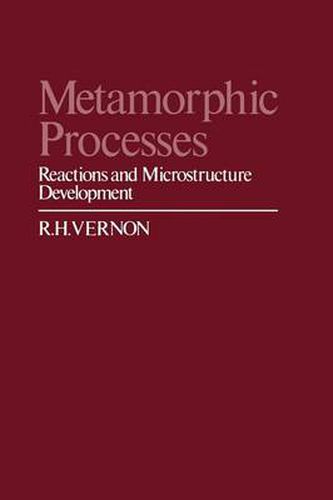Readings Newsletter
Become a Readings Member to make your shopping experience even easier.
Sign in or sign up for free!
You’re not far away from qualifying for FREE standard shipping within Australia
You’ve qualified for FREE standard shipping within Australia
The cart is loading…






This title is printed to order. This book may have been self-published. If so, we cannot guarantee the quality of the content. In the main most books will have gone through the editing process however some may not. We therefore suggest that you be aware of this before ordering this book. If in doubt check either the author or publisher’s details as we are unable to accept any returns unless they are faulty. Please contact us if you have any questions.
This book is for senior undergraduate or postgraduate students who want an insight into some modern approaches to metamorphic petrology. Its aims are to explain, in reasonably simple, informal terms, the processes underlying (i) metamorphic reactions and (ii) the production of micro structures in metamorphic rocks, these currently being the things that interest me most, geologically. The first aim requires discussion of equilibrium factors, reaction kinetics and reaction mechanisms, empha sising both the complexity of realistic reactions and the need to combine the chemical and microstructural approaches to them. The second aim requires discussion of deformation, recovery, recrystallisation and grain growth processes, with emphasis on experiments on silicate minerals. The book concludes with a general attempt to relate chemical and physical processes in metamorphism, although it will be clear from reading earlier chapters (especially Chapter 4) that the two aspects can rarely be separated completely in detailed metamorphic studies. Petrological and experimental investigations of metamorphic reactions and microstructural development are advancing so rapidly these days that students are faced with an ever-increasing volume of information and a relatively rapid obsolescence of data. So, in this book I do not try to be comprehensive, or to present much so-called ‘factual’ information. Instead, I deal more with basic principles, in the hope that these will guide the student in his or her encounters with the details of specific metamorphic problems.
$9.00 standard shipping within Australia
FREE standard shipping within Australia for orders over $100.00
Express & International shipping calculated at checkout
This title is printed to order. This book may have been self-published. If so, we cannot guarantee the quality of the content. In the main most books will have gone through the editing process however some may not. We therefore suggest that you be aware of this before ordering this book. If in doubt check either the author or publisher’s details as we are unable to accept any returns unless they are faulty. Please contact us if you have any questions.
This book is for senior undergraduate or postgraduate students who want an insight into some modern approaches to metamorphic petrology. Its aims are to explain, in reasonably simple, informal terms, the processes underlying (i) metamorphic reactions and (ii) the production of micro structures in metamorphic rocks, these currently being the things that interest me most, geologically. The first aim requires discussion of equilibrium factors, reaction kinetics and reaction mechanisms, empha sising both the complexity of realistic reactions and the need to combine the chemical and microstructural approaches to them. The second aim requires discussion of deformation, recovery, recrystallisation and grain growth processes, with emphasis on experiments on silicate minerals. The book concludes with a general attempt to relate chemical and physical processes in metamorphism, although it will be clear from reading earlier chapters (especially Chapter 4) that the two aspects can rarely be separated completely in detailed metamorphic studies. Petrological and experimental investigations of metamorphic reactions and microstructural development are advancing so rapidly these days that students are faced with an ever-increasing volume of information and a relatively rapid obsolescence of data. So, in this book I do not try to be comprehensive, or to present much so-called ‘factual’ information. Instead, I deal more with basic principles, in the hope that these will guide the student in his or her encounters with the details of specific metamorphic problems.